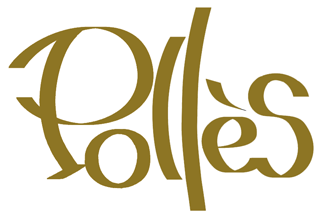PAR RÉGIS DEBRAY

IL N’EST SCULPTURE QUE DES ORIGINES
La lourde immobilité du bronze, du marbre ou du plâtre témoigne d’un voyage au bout de la nuit: retour aux sources de l’émotion, remontée du temps humain, soulèvement de l’âme la plus profonde. Le plus ancien des Beaux-Arts réveille en nous la préhistoire, et fait de nous, pour un instant, des primitifs. Cette regresio ad uterum, voilà qu’un jeune sculpteur la transforme en entreprise délibérée. Et presque littérale puisque l’utérus est son sujet – cette grande béance fantômatique surplombant l’origine des choses et de chacun. Enjambant Michel-Ange et Polyclète, Pollès nous rend contemporains des Déesses mamelues du paléolithique, ces outrancières allégories de la Terre et la Fécondité. Les retrouvailles avec l’archètype commandaient donc l’archaisme de la facture. Ce n’est pourtant pas d’histoire qu’il s’agit ici mais de quelque chose de beaucoup plus gênant et plus grave: une archéologie du fantasme.
Un jour sur un trottoir je me sentis arrêté, agressé, interpellé par un bronze dérrière une vitrine. Une femme assise, mains aux hanches, microcéphale et callipyge, proposait de toute éternité son vide central au passant. Cette agression aurait pu s’évanouir : elle se prolongea en un malaise tenace et sournois.
Inconsciemment aimanté, aimanté par mon inconscient, je revîns le lendemain regarder l’inconnue; ou plutôt traquer, débusquer sous l’impénétrable poli des surfaces, captant les rayons de lumière mais décourageant toute prise, quelque chose de très connu, situé loin en arrière et se dérobant à la mémoire. Je revîns à cette sculpture comme un criminel sur les lieux du crime, comme un névrosé à la scène originaire de son enfance, un rêveur à son rêve, énigmatique et pourtant familier. C’est ainsi que de fil en aiguille j’entrai chez Pollès: un peu comme qui va la première fois chez un psychanalyste.
Les formes de Pollès ont de quoi gêner, en effet. Elles ne jouent pas le jeu. Ambigues, insaisissables, elles sont ce qu’elles ne sont pas et ne sont pas ce qu’elles sont. Rien de moins « physique que ces corps offerts; rien de mois « esthétique » que ces Vénus difformes. Ces femmes épanouies, écrasées sous leur propre poids, vautrées dans l’inertie, ne chantent pas un hymne à la Joie. Regardez-bien ces faux Maillol, et vous comprendrez vite: ces fleurs de chair ont quelque chose de carnivore, de funèbre et de louche. Ces figures ne sont pas non plus hantées par le néant et la fugacité des êtres, comme l’étaient, à l’autre pôle de la sculpture, les signes émaciés de Giacometti, toujours menacés d’éffritement. Ces corps-là, insolents et presque obscènes de santé, plus larges que hauts, encore mal dégagés de la glaise primitive, n’annoncent nullement l’Apocalypse. Ils seraient plutôt du côté de la Genèse : un temps d’avant le temps, d’avant le partage du beau et du laid, quand le bon-goût n’éxistait pas encore. Ni copies d’êtres de chair, ni symboles d’une idée de la Chair. Ce sont des délires. Cette plastique est la fantasmagorie du désir. En quoi ces épouvantails érotiques touchent au tréfonds sacré de l’érotisme et en épousent l’ambivalence : attirance et répulsion, nausée et fascination, désir et dégôut tout à la fois. Monstres qui promettent le Paradis et découvrent l’Enfer.
Comme toutes les grandes oeuvres, la séduction qu’éxerce celle de Pollès provient d’un court-circuit, ou si l’on préfère, d’un quiproquo. Le comble de la matière rejoint le fond de l’immatériel. Voyez ces cuisses et ces ventres: ce n’est pas de l’embonpoint, c’est du cauchemar. Ce ne sont pas des rondeurs mais des vertiges. La plénitude, le débordement, la surabondance vitale sont ici mises au service de la part nocturne et secrète de l’homme. Spectaculaire, cette sculpture ne se donne pas en spectacle du dehors, elle vous pénètre par le dedans, comme une hantise. Agressivement matérialistes, ces formes intérieures empruntent leur pouvoir de harcèlement à un psychisme immémorial.
Pollès a retrouvé le paradigme perdu et lui donne son volume plastique. Il scelle les deux bouts de la chaîne. La nature des choses s’est fondu dans le délire des hommes, l’allègresse des formes vives a rattrapé l’inaltérable pesanteur de nos souffrances fondamentales.
Regis Debray
ENGLISH VERSION

The unmoving weight of bronze, marble or plaster bespeaks a voyage to the depths of night: it is a return to the sources of emotion, a journey back through human time, an upheaval of the deepest soul. The most ancient of the Fine Arts awakes the prehistoric in us and turns us for a moment into primitive beings. And here we have a young sculptor who makes a deliberate undertaking out of this regressio ad uterum . Almost literally so, for the uterus is his subject-matter; that phantasmal gaping open-ness shadowing every individual and overhanging the origin of all things. Pollès takes us back beyond Michelangelo and Polyclitus and transforms us into contemporaaries of the great-breasted paleolithic godesses who incarnate the most extravagant allegories of the Earth and Fertility. Hence, the archaism in the treatment of the work was governed by the renewed discovery of the archetype. This is not simply a matter of history, though. What is at issue here is something far more disturbing and serious: it is an archeology of the phantasy involved.
I was walking along the sidewalk one day when I found myself halted, aggressed and challenged by a bronze figure in a window. It was a microcephalous, callipygian female seated with hands on hips: she sat from all eternity offering her central cavity to the world at large. The sense of aggression could have just faded away, but instead it dragged on into a persistent, insidious feeling of uneasiness.
Unconsciously magnetized, magnetized by my unconscious, I went back the next day to take another look at the unknown woman: or rather to track down and unearth from beneath the impenetrable polish of her surfaces, which captured the light but deterred any hold, something very familiar, from a long way back, that eluded my memory. I returned to the sculpture like a villain to the scene of the crime, like a neurotic to the primal scene of his childhood, a dreamer to his dream – enigmatic, yet familiar. That was how, someone going to a psychoanalyst for the first time.
Pollès’ shapes are indeed disturbing. They do not play by the rules: ambiguous and elusive, they are what they are not and they are not what they are. Nothing is less”physical”than these offered bodies, nothing less “aesthetic” than these deformed Venuses. These overblown women, crushed beneath their own weight and wallowing in inertia, are not singin any Hymn to Joy. Take a good look at these deceptively Maillol-like figures and you will soon see why: there is something carnivorous, funereal and rather squalid about them. Neither are they haunted by the obsession with nothingness and the ephemerality of being that we find, at the other end of the sculptural scale, in Giacometti’s emaciated ciphers, which hover on the verge of disintegration. These squat bodies are insolently, almost obscenely robust, and still barely extricated from the primitive clay.They are not harbingers of the Apocalypse, but belong rather to Genesis: to a time before time, before the existence of any cleavage between beauty and ugliness, when there was still no such thing as “good taste “ . Neither copies of fleshly beings, nor symbols of an idea of Flesh, these are pure delirium. Their shapes are the phantasmagoria of desire. This is where these erotic scarecrows reach down into the sacred underworld of eroticism and assume its ambivalences: attraction and repulsion, disgust and fascination, desire and loathing all at once. Monsters that give promise of Paradise and knowledge of Hell.
As with all great works, the fascination exerted by Pollès’ sculpture arises from a short circuit or, if you prefer, an equivocal situation. The ultimate in physical substance is coupled with the final degree of immateriality. Look at these thighs and bellies: they are not just stout – they are nightmarish. What we have here is not rounded shapes, but sheer vertigo. Plenitude, excess and vital overabundance are submitted here to the service of the nocturnal, secret side of man. Although spectacular, this sculpture is not simply a spectacle for external viewing: it invades one from the inside, like an obsession. The powerfully discomfiting persistence of these aggressively materialistic inner forms takes its source in a psychism that goes back beyond memory.
Pollès has rediscovered the lost paradigm and given it plastic volume. He has soldered the two ends of the chain together. The nature of things has dissolved into fusion with the delusions of mankind, and the light-heartedness of living shapes has become bound up with the immutable weight of our most deep-rooted suffering.
Regis Debray
